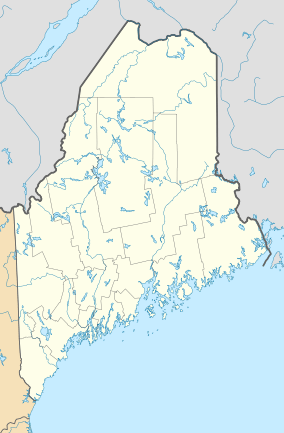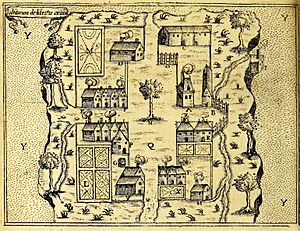Saint Croix Island, Maine facts for kids
Quick facts for kids Saint Croix IslandInternational Historic Site |
|
|---|---|
| Location | Washington County, Maine |
| Nearest city | Calais, Maine |
| Area | 6.5 acres (2.6 ha) |
| Established |
|
| Governing body | U.S. National Park Service and Parks Canada |
Saint Croix Island (also known as Île Sainte-Croix in French) is a small, empty island in Maine. Locals have long called it Dochet Island. It sits near the mouth of the Saint Croix River. This river forms part of the Canada–United States border, separating Maine from New Brunswick.
The island is in the traditional lands of the Passamaquoddy people. They used the island to store food safely away from mainland animals. In 1604, Pierre Dugua, Sieur de Mons tried to start a French settlement here. In 1984, the United States Congress named it the Saint Croix Island International Historic Site. You can't visit the island itself. However, there are visitor centers on the U.S. and Canadian mainlands nearby.
The island is about 6.5 acres (2.6 hectares) in size. It measures roughly 200 by 100 yards (183 by 91 meters). It is located about 4 miles (6.4 km) upstream from where the river meets Passamaquoddy Bay.
Contents
Discovering Saint Croix Island's Past
Island Names Through Time
The Passamaquoddy Nation lived around and used this island for many centuries. They had several names for it, like Muttoneguis and Metanegwis. These names often meant "great island" and "little island." They used it as a safe place to store things.
In the 1700s, Saint Croix Island became known as Bone Island. This was because erosion exposed many graves there. In 1969, twenty-three sets of human remains were moved from the island. They were reburied in 2003. Scientists found signs of scurvy in many of them. This confirmed why many early settlers died, as described by explorer Champlain. One skull even showed signs of an autopsy, which Champlain had ordered to find out what was causing the illness.
During the War of 1812, the island was considered neutral territory. Because of this, it was sometimes called Neutral Island. The French named it Ile Ste-Croix. It has also been called Demont's Island, Doucett Island, and Docea's Island, which eventually became Dochet Island.
Early European Settlement Attempts

In June 1604, a French nobleman named Pierre Dugua, Sieur de Mons started a settlement on Saint Croix Island. He had permission from King Henry IV. This outpost was one of France's first tries at living year-round in the area they called Acadia. Earlier attempts to settle in other places had failed.
The famous mapmaker Samuel de Champlain was part of this expedition in 1604. During their first winter on the small island, 35 out of 79 settlers died. They suffered from a "land-sickness," which people now believe was scurvy.
The next spring, Champlain and François Gravé Du Pont moved the settlement. They found a better spot on the southern shore of the Bay of Fundy. This new place was called Port-Royal. It became the first European settlement in New France. Champlain later left for France in 1607 and never returned to Acadia. However, in 1608, he started another settlement on the Saint Lawrence River. This place later became Québec, the first permanent European settlement in New France.
In 1613, after burning a French mission nearby, Samuel Argall also burned the old French buildings that were left on Sainte-Croix. Then he moved on to raid Port Royal.
Border Decisions and Commemoration


In 1797, there was a disagreement about the border between Britain and the U.S. A survey of the river decided that the island was on the western side of the main channel. This meant it belonged to the U.S.
In 2004, Canada released a special twenty-five cent coin. It honored the island and the start of Acadia there.
Saint Croix Island: An International Historic Site
The United States Congress officially named the island Saint Croix Island National Monument in 1949. It was added to the National Register of Historic Places in 1966. In 1984, Congress gave it its special name: International Historic Site. This makes it unique in the national park systems of both the United States and Canada.
Since 1968, the National Park Service has managed the island. They work from offices at Acadia National Park. They also talk with Parks Canada, which has a viewing area and information site on the New Brunswick side of the river.
Visitors are not allowed on the island itself. This helps protect the old historical remains. On the shore, there is a statue of Champlain and other displays. These tell the story of the island. In Canada, the island was first recognized as important in 1958. Parks Canada now runs the St. Croix Island International Historic Site at Bayside, Charlotte County. This site overlooks the island, similar to the U.S. approach.
Both nations often work together on events and promotions. In 2004, they held special events to mark 400 years since the French settlement in North America. In 2009, the U.S. website for the site started offering a full French translation. This was done by a teen volunteer named Olivier Fontenelle. The Parks Canada website has always been available in French.
See also
 In Spanish: Isla Saint Croix (Maine) para niños
In Spanish: Isla Saint Croix (Maine) para niños





